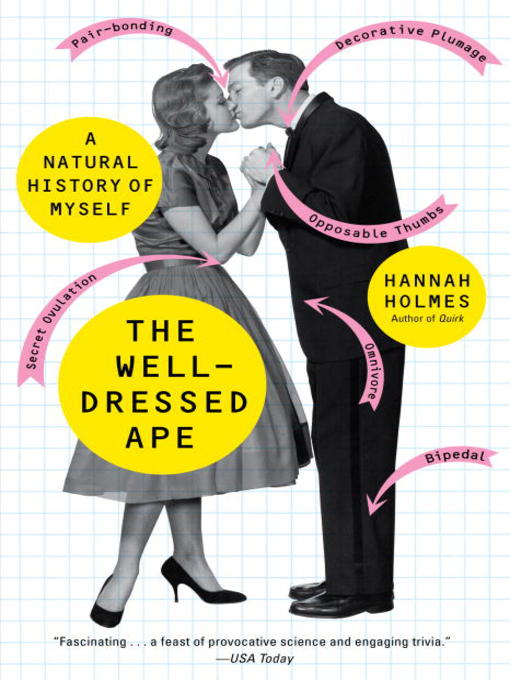
The Well-Dressed Ape
A Natural History of Myself
کتاب های مرتبط
- اطلاعات
- نقد و بررسی
- دیدگاه کاربران
نقد و بررسی

Starred review from November 10, 2008
Holmes (Suburban Safari
) has been “uncomfortable with the notion that I was an animal apart, a sort of extraterrestrial on my own planet.” Hence, she examines her “animal self,” hoping to “clarify my identity in the natural world.” As in her previous works, she uses the mundane to make larger points about life and the human condition. Beginning each chapter in a scientific mode, she then glides into more personal reflections (“I’m most aware of my brain when I encounter its limitations”) and then compares humans with other animals: “My wad of wiring is so hot and bothered that it puts all the world’s other brains to shame. Or does it?” Holmes thus continually underscores that humans are not nearly as different as many would have us believe. For example, a surprising number of species communicate fairly well, and prairie dogs actually have a sizable vocabulary. Holmes’s optimistic conclusion is that we are the only species capable of thinking about the effect of our actions and acting against narrow self-interest, even if we don’t always do so. Holmes makes the scientific personal in prose that is juicy and humorous, if occasionally a bit too cute.

Starred review from November 1, 2008
Science writer Holmes ("Suburban Safari, The Secret Life of Dust"), who is also a daughter of a biologist, has never come across a biological fact sheet for the species "Homo sapiens". In her new book, she creates and applies this fact sheet to herself and all other humans to show how we fit within the animal kingdom. With humor and clarity, she explores the facts, fictions, and hopes about the species "Homo sapiens". Each of the 11 chapters is devoted to one topic (the brain, perception, diet, communication, etc.), beginning with a short page or two of general description on the chapter's topic as applied to humans, while the remainder of the chapter delves into the topic from a scientific, cultural, and anthropological view. Holmes comfortably uses herself as the example for the topic, and the personalization works well. In reading the fact sheet about the species "Homo sapiens" we can each see how very much like other animals we are and at the same time how very different. Highly recommended for all science collections. [See Prepub Alert, "LJ" 9/1/08; library marketing.]Michael D. Cramer, Schwarz BioSciences, RTP, NC
Copyright 2008 Library Journal, LLC Used with permission.

June 1, 2009
Adult/High School-Head on, Holmes confronts the notion that human beings are just another mammal, essentially creating a field guide for Homo sapiens. Eleven chapters focus on a physical description, the brain, perception, range, territoriality, diet, reproduction, behavior, communication, predators, and ecosystem impacts. Each one begins with a clinical description (from one-half to a full page) of the subject discussed, which is then examined in detail by looking at a sample of Homo sapiens (the author herself) and then at different theories that explain why Homo sapiens are the way they are. Holmes is good at providing all sides of the storyoften, all current theorieseven those that contradict one another. In addition, she compares Homo sapiens to other animals, revealing our species' strengths and weaknesses, and our environmental impactthe good and the bad. The book combines comparative anatomy, biology, anthropology, and psychology and presents the information in a witty and humorous style that will attract even the most disinterested readers. This volume would be an excellent selection as a biology class review book."Kelliann Bogan, Colby-Sawyer College, New London, NH"
Copyright 2009 School Library Journal, LLC Used with permission.

December 1, 2008
Who are we, animally speaking? asks Holmes in this engaging look at Homo sapiensthat usesthe same cool objectivity scientists employ in viewing other species. In fact, she begins each chapter with the kind of fact sheet used by biologists to classify species, then adds delightful details based on scientific research and observations of her own body and her husbands. Comparing the human body with other animals, she notes the pros and cons: the scarcity of body fur, the length and straightness of limbs, teeth and claws unsuitable for hunting or defense, merely adequate eyesight, but an amazing brain and social abilities that greatly compensate for physical shortcomings. Deeply informed but whimsical, Holmes examines howand maybe whywe have evolved the way we have and the myriad differences between the sexes of our species and others. She also examines the impact of culture on our species, from painting ourselves and altering our fur (or hair) tohow our diet contributes to greater height from one generation to the next. Holmes brings fresh eyes toher look at our old species.(Reprinted with permission of Booklist, copyright 2008, American Library Association.)

























دیدگاه کاربران